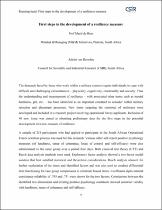JavaScript is disabled for your browser. Some features of this site may not work without it.
- ResearchSpace
- →
- Research Publications/Outputs
- →
- Conference Publications
- →
- View Item
| dc.contributor.author |
De Beer, Morris

|
|
| dc.contributor.author |
Van Heerden, A

|
|
| dc.date.accessioned | 2017-12-19T12:39:48Z | |
| dc.date.available | 2017-12-19T12:39:48Z | |
| dc.date.issued | 2016-11 | |
| dc.identifier.citation | De Beer, M. and Van Heerden, A. 2016. First steps in the development of a resilience measure. The 58th International Military Testing Association (IMTA) Conference, 7-11 November 2016, New Delhi, India | en_US |
| dc.identifier.uri | http://www.imta.info/conference/conference_home.aspx | |
| dc.identifier.uri | http://www.imta.info/PastConferences/Presentations_v2.aspx?Show=2016 | |
| dc.identifier.uri | http://hdl.handle.net/10204/9893 | |
| dc.description | Paper presented at the 58th International Military Testing Association (IMTA) Conference, 7-11 November 2016, New Delhi, India. | en_US |
| dc.description.abstract | The demands faced by those who work within a military context require individuals to cope with difficult and challenging circumstances – physically, cognitively, emotionally and socially. Thus the understanding and measurement of resilience – with associated other terms such as mental hardiness, grit, etc. – has been identified as an important construct to consider within military selection and placement processes. New items targeting the construct of resilience were developed and included in a research project involving operational forces applicants. Inclusion of 40 new items was aimed at obtaining preliminary data for the first steps in the potential development of a new measure of resilience. A sample of 251 participants who had applied to participate in the South African Operational Forces selection process was used for this research. Various other self-report positive psychology measures (of hardiness, sense of coherence, locus of control and self-efficacy) were also administered to the same group over a period four days. Both classical test theory (CTT) and Rasch data analysis methods were used. Exploratory factor analysis showed a two-factor model solution that best satisfied statistical and theoretical considerations. Rasch analysis allowed for further exploration of the items and identified factors and was also used to conduct differential item functioning for race group comparisons to eliminate biased items. Coefficient alpha internal consistency reliability of .793 and .751 were shown for the two factors. Correlations between the identified two dimensions and existing positive psychology constructs showed construct validity with hardiness, sense of coherence and self-efficacy. | en_US |
| dc.language.iso | en | en_US |
| dc.relation.ispartofseries | Worklist;18100 | |
| dc.subject | Resilience measures | en_US |
| dc.subject | Military testing | en_US |
| dc.subject | Military coping mechanisms | en_US |
| dc.title | First steps in the development of a resilience measure | en_US |
| dc.type | Conference Presentation | en_US |
| dc.identifier.apacitation | De Beer, M., & Van Heerden, A. (2016). First steps in the development of a resilience measure. http://hdl.handle.net/10204/9893 | en_ZA |
| dc.identifier.chicagocitation | De Beer, Morris, and A Van Heerden. "First steps in the development of a resilience measure." (2016): http://hdl.handle.net/10204/9893 | en_ZA |
| dc.identifier.vancouvercitation | De Beer M, Van Heerden A, First steps in the development of a resilience measure; 2016. http://hdl.handle.net/10204/9893 . | en_ZA |
| dc.identifier.ris | TY - Conference Presentation AU - De Beer, Morris AU - Van Heerden, A AB - The demands faced by those who work within a military context require individuals to cope with difficult and challenging circumstances – physically, cognitively, emotionally and socially. Thus the understanding and measurement of resilience – with associated other terms such as mental hardiness, grit, etc. – has been identified as an important construct to consider within military selection and placement processes. New items targeting the construct of resilience were developed and included in a research project involving operational forces applicants. Inclusion of 40 new items was aimed at obtaining preliminary data for the first steps in the potential development of a new measure of resilience. A sample of 251 participants who had applied to participate in the South African Operational Forces selection process was used for this research. Various other self-report positive psychology measures (of hardiness, sense of coherence, locus of control and self-efficacy) were also administered to the same group over a period four days. Both classical test theory (CTT) and Rasch data analysis methods were used. Exploratory factor analysis showed a two-factor model solution that best satisfied statistical and theoretical considerations. Rasch analysis allowed for further exploration of the items and identified factors and was also used to conduct differential item functioning for race group comparisons to eliminate biased items. Coefficient alpha internal consistency reliability of .793 and .751 were shown for the two factors. Correlations between the identified two dimensions and existing positive psychology constructs showed construct validity with hardiness, sense of coherence and self-efficacy. DA - 2016-11 DB - ResearchSpace DP - CSIR KW - Resilience measures KW - Military testing KW - Military coping mechanisms LK - https://researchspace.csir.co.za PY - 2016 T1 - First steps in the development of a resilience measure TI - First steps in the development of a resilience measure UR - http://hdl.handle.net/10204/9893 ER - | en_ZA |






